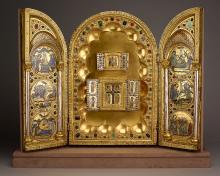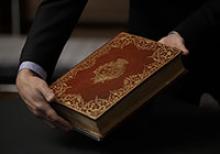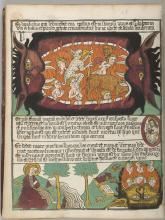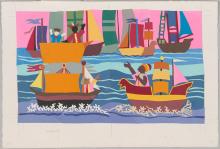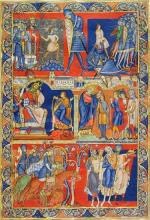Plan your visit. 225 Madison Avenue at 36th Street, New York, NY 10016.
Plan your visit. 225 Madison Avenue at 36th Street, New York, NY 10016.
Conservation
Behind the Scenes: Conservation on the Stavelot Triptych
Submitted by Communications ... on Thu, 04/13/2017 - 11:07amIt's extra bright in Gilbert Court now that the Morgan's extraordinary Stavelot Triptych is back on display.
The splendid twelfth-century object (from the Abbey of Stavelot in Belgium) was originally intended to hold relic fragments of the True Cross.
Bound for Versailles: Investigating the Jayne Wrightsman Bookbindings Collection
Submitted by Thaw Conservati... on Wed, 06/23/2021 - 2:54pmIn anticipation of the upcoming exhibition Bound for Versailles: The Jayne Wrightsman Bookbindings Collection, on view June 25 through September 26, 2021, our conservators from the Thaw Conservation Center took a close look at techniques used in creating these elaborate works of art.
Color and Curious Creatures: Fifteenth-Century Block Books at the Morgan
Submitted by Thaw Conservati... on Wed, 07/08/2020 - 7:00pmColor and Curious Creatures: Fifteenth-Century Block Books at the Morgan, Part II
Submitted by Thaw Conservati... on Fri, 08/21/2020 - 11:52pmAn earlier post discussed some of the traditional colors that appear in the Morgan’s block books. In most cases, the hand-applied colors are typical of the dyes and pigments seen in the Middle Ages and Renaissance. However, a few unexpected pigments were discovered during the study of these fifteenth-century books, enabling a better understanding of how some of them were changed over the centuries.
Color and Texture: An exploration of Ashley Bryan's collage papers
Submitted by Thaw Conservati... on Fri, 01/13/2023 - 10:55amThis is a guest post by Lindsey Tyne, Conservation Librarian, NYU Libraries
Ashley Bryan (1923–2022) used colored and hand-painted papers cut into the shapes of people, ships, water, land, and sky to create the collages that fill the pages of Sail Away, 2015, as printed images. When these eighteen collages (2021.25:1–18) entered the collection of the Morgan Library & Museum in 2021 as a gift of the Ashley Bryan Center, I was drawn to the rich colors and textures of the collage papers and immediately recognized one paper, Canson Mi-Teintes®, by its distinctive honeycomb texture.
Conference Presentations
Submitted by Thaw Conservati... on Tue, 06/14/2016 - 9:28pmConservators working in the Thaw Conservation Center at the Morgan Library & Museum undertake technical research projects relating to the objects they are treating for the Morgan's robust exhibition and loan program, for digitization, and for scholarly access in the Reading Room.
Conservation treatment of Haydn's The Seven Last Words of Our Savior on The Cross (Cary 508)
Submitted by Thaw Conservati... on Mon, 07/17/2017 - 12:16pmIn 1786, the Clergy of the Cadiz cathedral in Spain commissioned Joseph Haydn (1732–1809) to compose The Seven Last Words of our Saviour on the Cross. In 1791, a copyist’s manuscript of the full orchestral score, with annotations by Haydn himself was prepared for a series of concerts to be held in London.
Corners and Edges: The Physical Evidence of Édouard Vuillard’s Sketchbooks
Submitted by Thaw Conservati... on Mon, 04/05/2021 - 10:12pmSeveral of the drawings included in Édouard Vuillard: Sketches and Studies come from sketchbooks spanning the artist’s entire career with dates as early as the 1890s to the 1930s. This exhibition provides the unique opportunity to learn about Vuillard’s preferred sketching materials. While preparing the drawings for installation, I looked for connections between them, with particular attention to similarities and differences in the physical evidence.
Distrust in the Strength of Paper, Part I
Submitted by Thaw Conservati... on Mon, 11/27/2023 - 1:00pmIn the history of European bookbinding, the transition from parchment to paper as the primary material for text leaves caused an associated shift in bookbinding practices, as bookbinders adapted to what they thought of as a weaker material. Parchment is made of animal skin, prepared by dehairing, stretching, scraping, and drying, whereas paper at the time was made of plant-based materials, such as cotton and flax.


